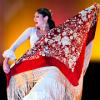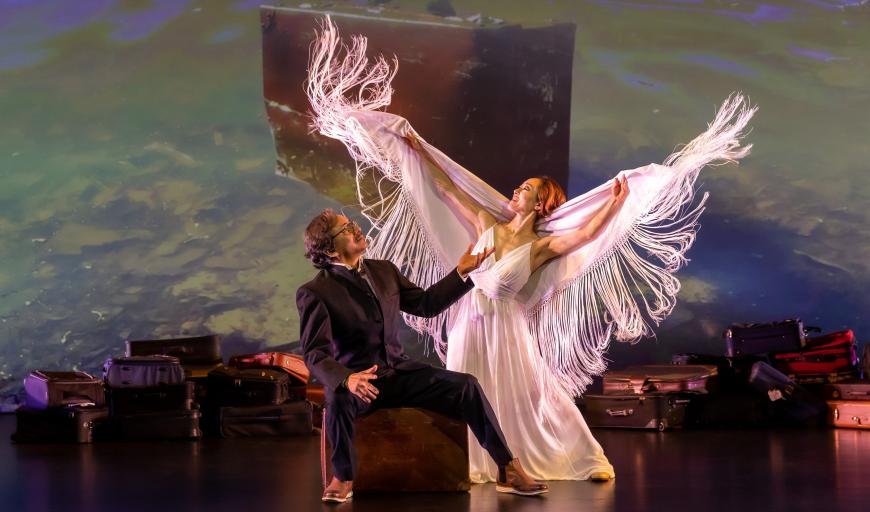
In a time of news stories about the destruction and suffering caused by climate change, the disruptions of immigration policies, and other disasters and wars, we may feel stuck in a state of crisis. The arts have been addressing this feeling for centuries; think of well-known examples like Kurt Jooss’s ballet The Green Table, Picasso’s Guernica, and Paul Taylor’s Company B. The arts, too, can bring escape or comfort, offering respite or aid in building renewed strength to survive horrific experiences.
The premiere of Solaz, a multimedia flamenco work created by La Tania and presented by the Presidio Theatre this weekend, examines in depth the emotions of displacement and what finding solace in the process of learning to cope might look like.
The project started when Julie Mushet, the former executive director of World Arts West, was emotionally moved by a visit to the ancient Egyptian Temple of Debod, located in Madrid since 1972. In the 1960s, that temple and several others (like the Temple of Dendur, now in New York’s Metropolitan Museum of Art) were rescued by UNESCO intervention before the flooding of Nubia by Egypt’s construction of the Aswan High Dam. The Temple of Debod, built in the second century B.C. and ultimately transported to and reconstructed in Spain, now serves as a beacon of cultural survival in the face of global displacement.
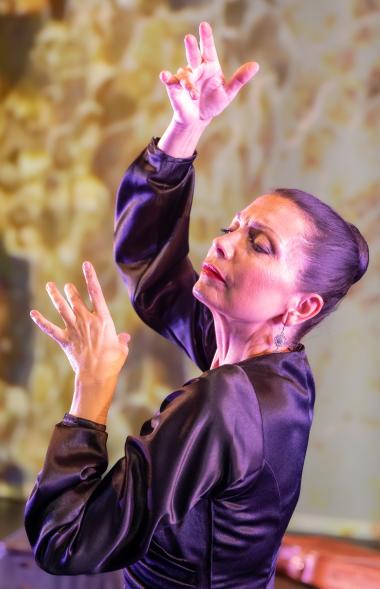
Mushet wanted to celebrate the 50th anniversary of the temple’s relocation in 2022, and she knew that La Tania was the perfect artist to fulfill her dream. After funding was secured through the Creative Work Fund and the Kenneth Rainin Foundation, the artistic team set to work at the beginning of the COVID pandemic.
Solaz’s artistic directors — La Tania, who also serves as choreographer, and Adrián Arias, the multidiscipline artist who created the work’s visual projections — along with composer José Luis de la Paz, started collaborating through Zoom sessions. With La Tania in Seville, Arias in San Francisco, and de la Paz in Florida, they had little choice but to follow a virtual path. Only in the last month has everyone, including the dancers, been together in San Francisco.
La Tania’s own life experience is a journey of displacement. It began with her grandmother, the American painter Judith Deim, who left her hometown of St. Louis and moved to California in the 1930s, cutting all ties to her family. Once there, she married a fellow artist and had four children. In the late 1950s, she divorced her husband and took her children to Europe.
Born in Arles, France, La Tania moved to Morón de la Frontera, a small Romani enclave in Andalusia, at the age of 2. Her mother took up flamenco dance and her uncle flamenco guitar. Raised with the Romani people, La Tania learned to dance in a natural way, as flamenco music and dance was a daily activity.
Her grandmother, needing to move constantly, traveled to Senegal and then to Morocco. When La Tania was 13, her mother died in Spain, prompting her grandmother to move the family back to the United States. They landed in Willits, a small town in northern California. The culture shock for La Tania was compounded by being forced to go to school for the first time.
The tragedy of losing her mother and relocating to a foreign country made her feel a sense of dread and of not belonging. The moving continued, first to San Francisco, then back to Willits, and then to Monterey, all in the span of four years.
At 17, La Tania had the opportunity to audition for a dance company in Spain, and off she went with one suitcase and one pair of flamenco shoes to begin her development as a professional dancer.
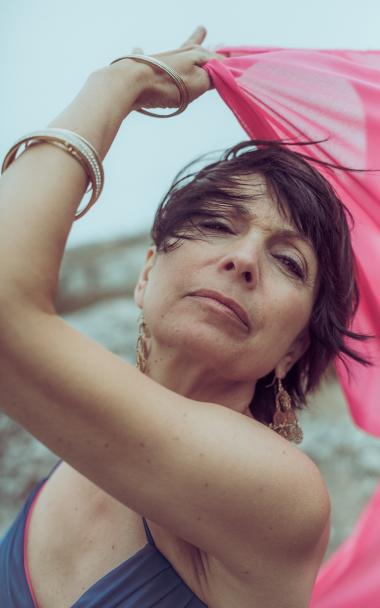
She lived in Mallorca for four years, dancing in various companies, and then moved to Madrid to start all over again. Even though she spoke perfect Spanish, she was made painfully aware of being a French American and not a Spaniard.
In Madrid, she gained a reputation as a top-level dancer and got an offer to dance in an all-star company, Cumbre Flamenca, that was going on a world tour. But when the troupe found out that she was not a Spaniard, it rejected her based on her nationality. She found this very depressing and felt that she would never really belong or be accepted anywhere.
She returned to the United States and spent three decades building a life and community here in San Francisco, becoming a brilliant, award-winning performer and choreographer. Recently she was displaced, like many artists, by the escalating costs of living and working in the Bay Area. After losing her San Francisco home and studio to gentrification, she returned to Spain.
During an interview with La Tania and Arias in the Green Room of the Presidio Theatre, it became clear why and how Solaz evolved and took the form it has.
“We lived in Morocco with my grandmother,” La Tania says. “She played a lot of Arabic music and Egyptian music. So I grew up with that and always loved it. The tie-in with flamenco is an influence in their music.”
She continues, “The beauty of these types of collaborations is that what comes out is unique because you’re bringing out different styles and different ways of seeing things. The show would not be what it is if I had done it alone. It’s the combination of influences [from all of us]. With José Luis, the guitarist and composer, doing it long-distance feels like a collage we put together.
“The music is flamenco with a touch of oriental [influence], but that’s very, very complicated because with two different forms of music, you need to have people [working] together for a long time. The temple is in Madrid, so it’s not about making a fusion but about honoring that displacement and the whole idea of that temple coming from Egypt. We have Faisal [Zedan] and Gary [Haggerty] playing derbakki [an Arabic drum] and oud [the Arabic lute], but it’s in a subtle way.”
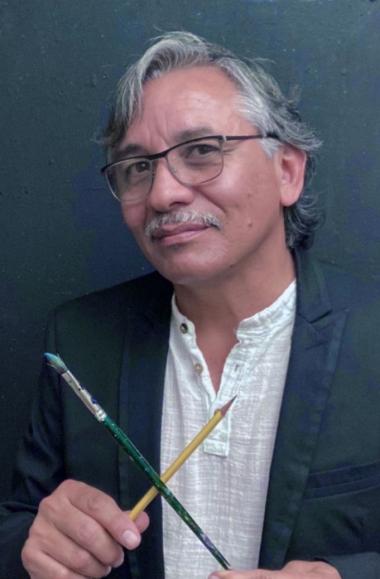
Arias adds, “It was so good to work with José Luis. I remember he changed several things when we talked about them. He gets the real sense of [what we want]. He asked, ‘What is the sound of a root growing?’ Very, very slow, and suddenly it’s raining. It’s like an inspiration for the root to transform into a little plant.”
Arias continues, talking about the temple, “The symbol was so strong — how not only humans can move from one place to another but cultures [can] leave and be acknowledged in another completely different place. Also, the shape of the temple was an inspiration for us. When we were writing the script, I remember working with this idea that every suitcase could be a brick or a star, or we can just build a temple with suitcases. And at the same time, every suitcase has a story that belongs to a human, and the human struggle is usually with suitcases, with bags, and [people] put in the special things that they really like to keep and that have significance.
“Tania and I, we grew up in families almost like gypsies, moving all the time. I remember studying in eight different schools in my childhood because my parents’ work was moving all around Peru. I got inspired by Tania’s stories, my personal stories, when we wrote the script. The piece is basically elements like the air, having a little plant growing or a chrysalis and how a beautiful butterfly is born but just for a moment and dies. It’s about how transcendent is life. Because we are living in a time of a lot of displacement, diaspora, we have political and social provinces with borders, with lines that divide spaces. But in the Bay Area, we are recognizing that we are on Ohlone [Native American] land. It’s so important to recognize this is not my land, the land doesn’t belong to humans, and we need to acknowledge the land. All those elements together at the end [helped] to create this piece, this Solaz.
“I came here 23 years ago, and at the very beginning, I felt like I was an immigrant. But now I don’t think that because we are not immigrants when we are moving. If I am a butterfly and I go into the next garden, I’m not an immigrant in that garden: ‘Excuse me, I have the right to live in the garden.’ We are humans in other places.”
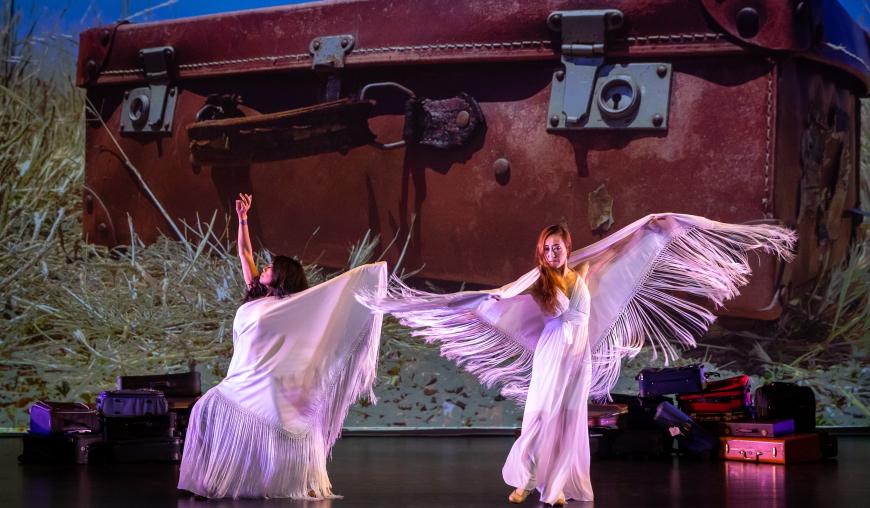
Arias explains, “I was filming nature to put together with the amazing choreographies that [La Tania] created. And my images sometimes came first, then the choreography later, but sometimes the reverse. The image plays with the choreography, mixing and dancing within the creation. And that was crazy because we worked [from] a distance when she was in Seville for a year.
“In one case, I remember seeing Tania’s choreography; how it looked gave me the idea I needed to go to the ocean. I spent three days in the Mendocino area, getting all the waves, rocks, trees, and fruit. I started working intuitively, looking for different angles. I try to create a poetic angle of a space.”
La Tania agrees that “the choreography and the images behind are totally related in a poetic way. The dancers are part of the video, and the video is part of the movements.
“I [choreographed] a layer that has to do with the roots and the tree, the growing and the strength of the tree, so you have that whole imagery. And José Luis thought about it. So we’re all in that [same] imagery. When you do that, the music is perfect. And even when I tried to be more dancy with it, I couldn’t. I just had to keep playing the tree, growing slowly, the leaves and other branches going different ways and expressing themselves.
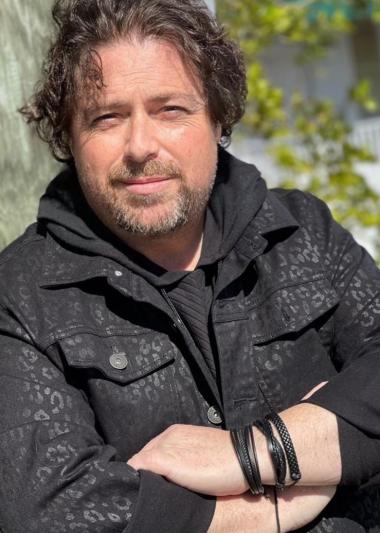
“When there’s imagery that each person works on, it just is very organic. And that’s what I wanted, not to be overly structured, thought out, and contextualized. It was more about the feeling. In flamenco, the stories are told through emotion — feeling more than conceptual — and so to me that connects a lot with nature.”
The choreographer has assembled a dream team of dancers in addition to herself — Melissa Cruz, Cristina Hall, and Mizuho Sato. “It’s really important to get dancers that you know are very personal with what they do and are professional always. They have their own style of dancing, so it was great collaborating with them. I don’t want everybody to look the same. There are some parts that are synchronized, some parts that are not, and some parts that I wanted to be organic for the dancers. I always ask them to do something that’s uncomfortable. If it feels better another way, work with it. It’s got to be like this because with flamenco you develop in a very individualistic way.”
Solaz is the kind of art we need as the world presents more challenges. And maybe, it’s also a respite from those challenges.
Solaz will be performed July 21 and 22 at 7 p.m. and July 23 at 4 p.m. at the Presidio Theatre in San Francisco. Tickets can be purchased online.



